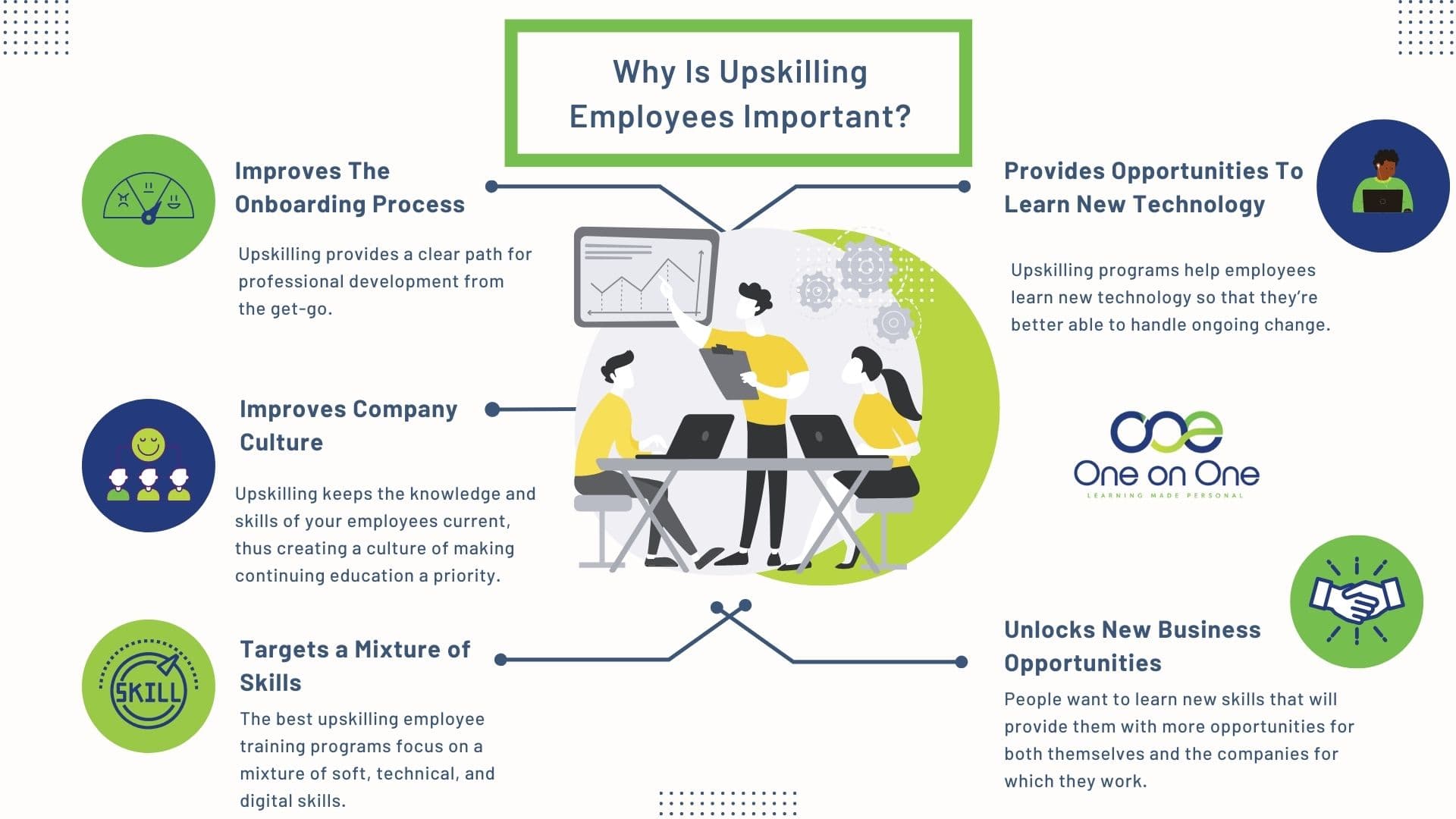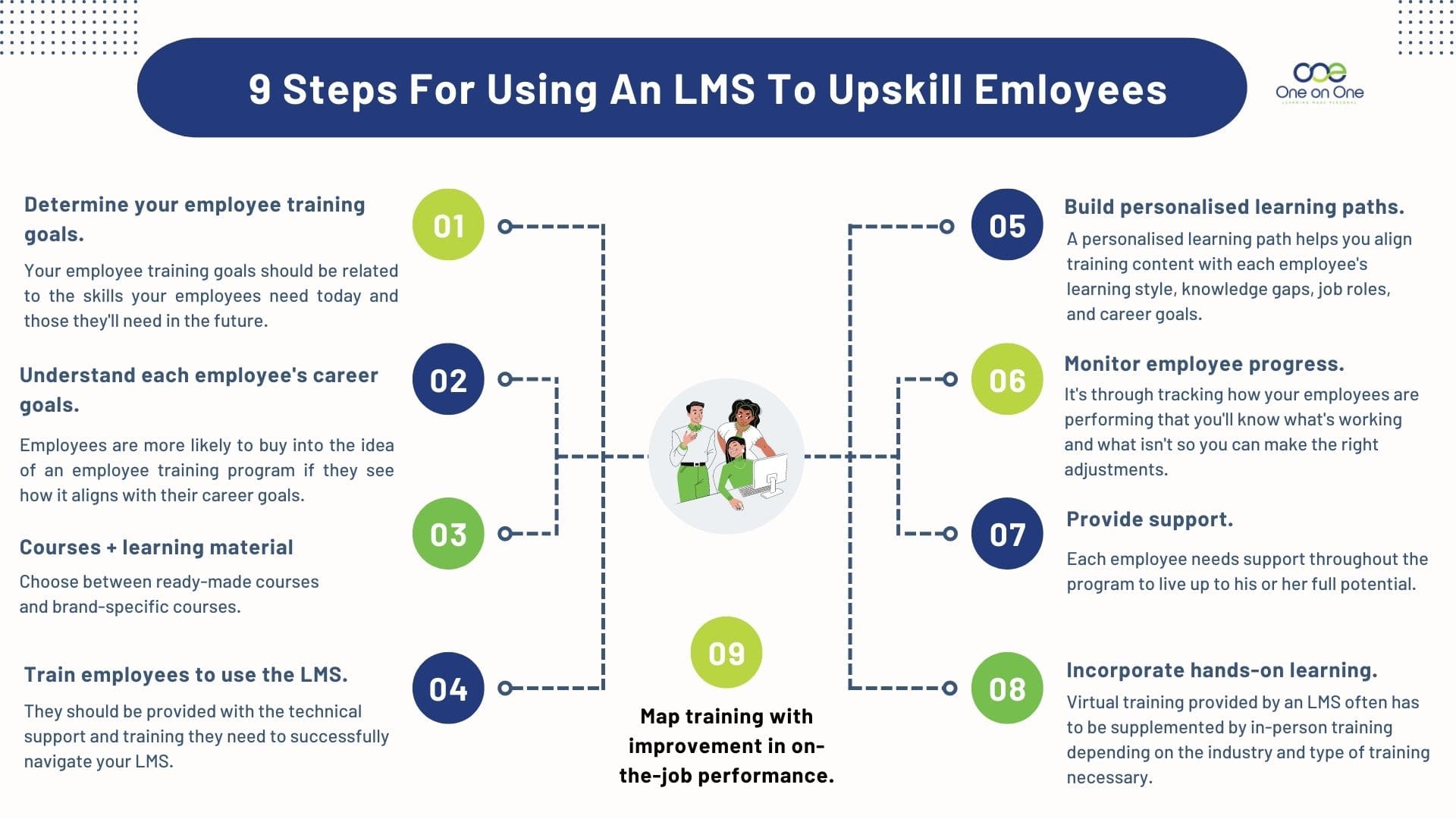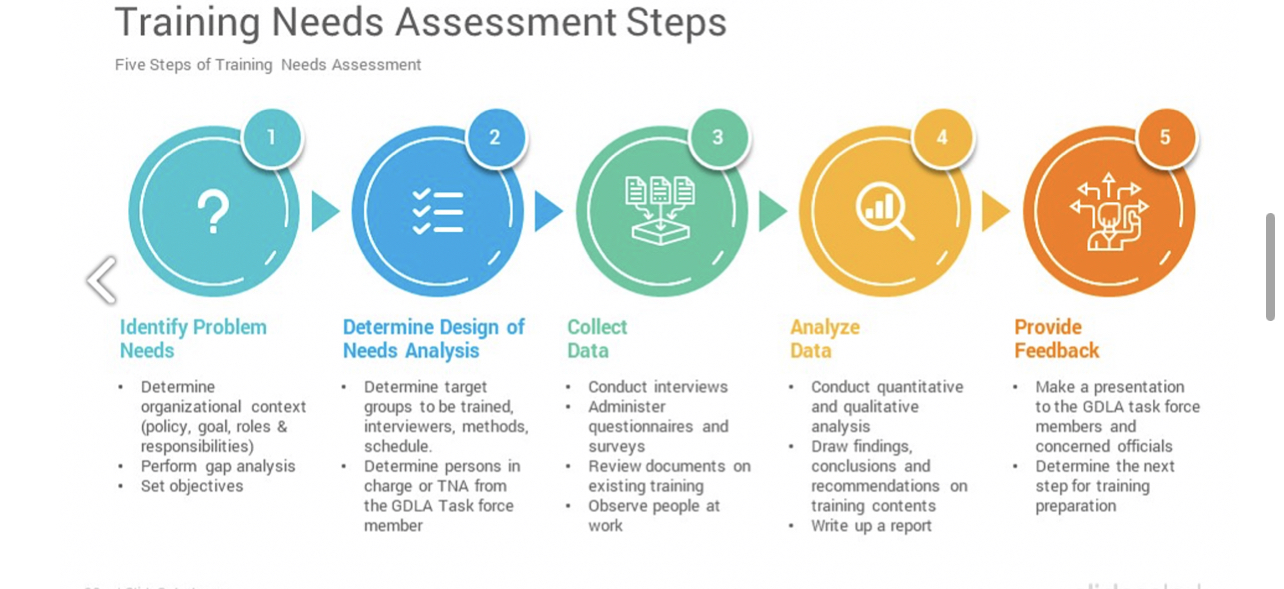LMS & Employee Training: A Step-By-Step Guide For Upskilling Your Caribbean Workforce
Upskilling employees is one of the best benefits of employee training. This article explains the importance of upskilling employees and how an LMS can support the process in nine steps.
By Christine McLean
The Caribbean is a region of excellence despite having a total population that’s almost the same size as California. We’re known for our flavourful cuisine, energetic entertainment, hospitality, and strong work ethic.
However, we’re not effectively reaching and educating our people to meet modern labour demands. Dr. Suresh Narine, a Guyanese STEM professor based in Canada, shared in a guest lecture that the Caribbean has a very siloed approach to education, one that leads to inadequate training and supports our dependency on tourism as our economic saviour.

The Caribbean’s future depends heavily on our investment in STEM training that supports innovation. It also depends on how effective Caribbean companies are at not only increasing the STEM education of their employees, but also training them in the soft and industry-specific skills they need to excel.
That’s why a well planned and well executed employee learning and development program is important for Caribbean companies. Programs like these equip Caribbean workers with the skills they need to meet the increasing demands of customers. They also make regional companies viable choices in a highly competitive global environment.
So, how can you create a well planned and well executed employee learning and development program for your Caribbean workforce? You need two key ingredients — a Learning Management System (LMS) and a culture that promotes and supports ongoing employee training.
In this article, we’re diving into what an LMS is and how you can use it to upskill your employees while building a culture of ongoing employee training.
What Is A Learning Management System (LMS)?
A learning management system is a software application that provides a seamless process for asynchronous and real time virtual training. It’s a hub for course material people can access anytime, anywhere. The typical features of an LMS include:
- Access to a wide variety of learning material including videos, articles, and audio recordings
- Opportunities to test learners and get real time data on their progress and the topics they struggle with the most
- A central area for storing and organizing training material virtually
- Discussion forums for peer-to-peer communication that further enhances learning
Why Is Upskilling Employees Important?

An LMS makes it easier to upskill employees because they can learn at their own pace and in a way that suits their learning styles. Aside from keeping Caribbean employees relevant, upskilling provides five additional benefits for organisations.
1. Upskilling Improves The Onboarding Process
According to a Gallup study, “Employees who strongly agree they have a clear plan for their professional development are 3.5 times more likely to strongly agree that their onboarding process was exceptional.” Employees should know from the get-go how your company will support their professional development needs. Part of this process is being clear on the learning and development training programs they’ll participate in to upgrade their skills and open themselves to more opportunities.
2. Company Culture Benefits From Upskilling Programs
Pricewaterhouse Cooper’s (PwC’s) 23rd Annual Global CEO Survey revealed that 41% of CEOs believe “their upskilling program has been very effective in creating a stronger company culture and engaging employees.” Upskilling keeps the knowledge and skills of your employees current, thus creating a culture of making continuing education a priority. As your employees continue to upgrade their knowledge and skills, they’re better able to keep customers happy.
3. A Mixture Of Skills Are Targeted During Upskilling
Upskilling initiatives aren’t limited to technical training or the development of hard skills. The best upskilling employee training programs focus on a mixture of soft, technical, and digital skills. However, PwC’s study also shows that only 18% of CEOs have made significant progress towards establishing these types of programs. This provides a unique opportunity for you to set your Caribbean organisation a part through a well-balanced upskilling program.
4. Upskilling Helps Employees Learn New Technology And Manage Change
PwC also conducted a Caribbean Digital Readiness Survey. One of the interesting findings from the report was that “46% of Caribbean businesses are behind on training workers for the digital era.” At its core, an upskilling program helps employees learn new technology so that they’re better able to handle ongoing changes. Don’t be part of the 46%! Otherwise, your organisation will be left behind.
5. Upskilling Helps Employees Unlock New Opportunities For Businesses
One On One partnered with Flow Foundation’s Digital Education initiative to help thousands of Jamaicans complete over 4,000 online courses and 700 modules. This initiative was part of a drive to upskill Jamaica’s workforce and make them ready for the digital age.
All participants were assigned customized learning paths based on their specific needs. They were also supported through gamification, webinars, WhatsApp groups, and other digital channels. All in all, this initiative improved the skills of a large group of Jamaicans who were, therefore, better equipped for the modern workforce.
The rate of course completion demonstrates a demand for these types of initiatives not only in Jamaica but across the entire Caribbean region. People want to learn new skills that will provide them with more opportunities for both themselves and the companies for which they work.
9 Steps For Using An Online Learning Management System To Upskill Employees

Employee training programs are useless if an LMS isn’t used correctly. We’ve worked with several corporate clients, and our experience has taught us that there are nine clear steps that should be followed when using an LMS to upskill employees.
1. Determine Your Employee Training Goals
Your employee training goals should be related to the skills your employees need today and those they’ll need in the future. However, these goals should also be aligned with specific company objectives and gaps you’ve identified within the organisation. That’s why you should always start with a training needs analysis.
A training needs analysis will help you:
- Involve key stakeholders within the organisation so that the training goals are a true reflection of what’s needed
- Identify skill gaps for individual employees
- Determine the best training strategies based on the needs identified
- Prioritize training initiatives for both short-term and long-term success
The image below explains how a training needs analysis works.

Image Source: SlideSalad
Here are two resources that can help you do an effective training needs analysis.
2. Understand Each Employee’s Career Goals
While doing a training needs analysis is important for pinpointing your overall employee training goals, each employee’s career goals should also be considered. Employees are more likely to buy into the idea of an employee training program if they see how it aligns with their career goals. They want to know what’s in it for them before they are fully committed and engaged.
Also, millennials comprise most of the modern workforce since Baby Boomers are aging out of the work world. Millennials approach work differently. As the Manpower Group states, “Millennials think about careers in waves with changing paths, pace, and regular breaks.” They want work that increases their long-term employability.
Therefore, it’s important for you to be mindful of each employee’s career goals. Use our career planning template for employees as a guide for putting employee career goals together and ensuring they match up to what you discovered during your training needs analysis.
3. Select The Best Combination Of Courses And Learning Material
Now that you’ve identified your organization’s overall learning and development goals and each employee’s career goals, the next step is to choose the courses and learning materials that would work best for your learning and development program. An LMS provides two main options:
- A library of ready-made courses
- Brand-specific courses based on unique instructional design
Each option has its pros and cons which we’ve summarised below.
Pros Of Ready-Made Courses
- Easily find content that has already been created on a wide range of topics.
- Choose from a variety of content types.
- Some courses are taught by people who are leaders in their field.
- It’s less expensive to create a learning and development program since these courses are ready to go.
Cons Of Ready-Made Courses
- The courses aren’t tailored to the unique needs of your organization.
- It may be difficult to understand some of the instructors because of their accents or teaching style.
- The material may be better suited for people who live in specific regions.
Pros Of Brand-Specific Courses
- The courses aren’t tailored to the unique needs of your organization.
- It may be difficult to understand some of the instructors because of their accents or teaching style.
- The material may be better suited for people who live in specific regions.
Con Of Brand-Specific Courses
- Requires a larger financial investment because courses are custom-made.
4. Train Employees To Use The LMS
Employees shouldn’t be thrown into the deep end. They should be provided with the technical support and training they need to successfully navigate your LMS. This training should be available during the onboarding process and before each training program begins.
5. Build Personalised Learning Paths
A personalised learning path helps you align training content with each employee’s learning style, knowledge gaps, job roles, and career goals. It helps you provide content that’s relevant to each employee, which is something that’s difficult to do with group employee training programs. The insights you’ve gathered from the previous steps will help you create personalised learning paths for your employees.
An LMS provides the bridge between identifying each employee’s training needs and using that data to build personalised learning paths. The data an LMS provides will help you learn more about who your employees are and how they’re interacting with your training content. The artificial intelligence (AI) within the LMS software uses this data to recommend courses and further training opportunities based on the employee’s role, skill level, and career path. Also, the AI can provide recommendations for additional study material if an employee is struggling with answers to specific quiz questions throughout a course.
One On One’s LMS provides Job Skill Profiles which are distinct learning paths based on job functions. They help new employees understand how they can advance in an organization and the training they need to get there.
6. Monitor Employee Progress
Keep on top of the data your LMS provides! It’s through tracking how your employees are performing that you’ll know what’s working and what isn’t so you can make the right adjustments. Here are some key questions you can ask to better monitor how your employees are performing:
- What’s the course completion rate? A low course completion rate could be caused by many things including poorly designed courses, lack of accessibility, and lack of incentives to motivate completion. You have to do a deep dive to determine the root cause.
- How are they performing on quizzes? Your courses should have regular quizzes throughout that assess what employees are learning prior to a final exam. Your admin dashboard gives you a bird’s eye view on questions that are challenging to most of your employees, as well as where individual employees are struggling the most.
- What’s the average view duration for course videos? Videos are one of the many types of course material that you’ll be creating for your employee training program. The best metric to use for assessing whether your videos are actually resonating with your employees is to look at the average view duration. If this metric covers at least 80% of the video’s total length, you’re on the right track but there’s a problem if the percentage is lower.
- Where are the learning gaps? The bird’s eye view data will give you a good sense of where the learning gaps are and help you put a plan in place for filling those gaps.
7. Provide Support
A successful employee training program isn’t only about getting employees to complete courses so you can hit your training quota. Instead, it’s about providing each employee with the support needed to upskill and live up to his or her full potential. The data you get from step six provides the roadmap you need to offer the best possible support to each employee.
Here are some additional tips that can help you provide ongoing support for your employees:
- Encourage employees to share their feedback on the courses and training material provided in the program.
- Provide support without judgement. If possible, have face-to-face or virtual video conversations instead of communicating via text messages and emails. A lot can get lost in written communication. Be empathetic and ready to help.
- Have a team member specifically assigned to provide the reports you need monthly so that no one falls through the cracks. It can be challenging to handle all the moving parts alone so having a team member provide the help you need is a great option.
8. Incorporate Hands-On Learning
Virtual training provided by an LMS often has to be supplemented by in-person training depending on the industry and type of training necessary. For instance, some compliance departments need mass training sessions where industry experts present to their teams in real-time but also need to provide employees with additional training material they can go through asynchronously.
There’s nothing wrong with adopting a hybrid approach to learning and development. But it’s only through assessing your company’s resources, the makeup of your employees, and how best your employees learn that you’ll definitively know whether a hybrid approach will work or not.
9. Map Training With Improvement In On-the-Job Performance
The true test of whether your employee training works is whether the training goals were achieved and on-the-job performance improves. Work with department heads and other leaders within the organization to evaluate how employees perform three months after the training program has ended.
Bonus Tip: Create A Competency-Based Culture Of Learning
You’ll get more buy-in for ongoing learning and development within your organization if it’s ingrained in your company’s culture. Ongoing learning should be tied to:
- Your employee rewards program. What will employees gain beyond upskilling?
- Making customer satisfaction a priority. Ongoing employee learning and development ultimately improve customer satisfaction.
- Keeping employees happy and engaged.
Upskill Employees With Online Employee Training
Creating a learning and development program that upskills employees will bring many benefits to your Caribbean organization. The future of the Caribbean’s workforce depends heavily on how all Caribbean-based companies invest in upskilling their teams. It’s an investment that will lead to a workforce that’s more innovative, customer-ready, and committed to the region’s growth.
One On One is here to help you design courses and set up an LMS that meets your organization’s needs. Schedule a demo today and let’s discuss how we can help your employees thrive.

